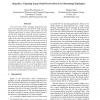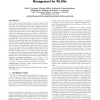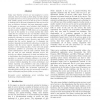9997 search results - page 35 / 2000 » The case for crowd computing |
WOA
2010
13 years 8 months ago
2010
Models for the simulation of pedestrian dynamics and crowds of pedestrians have already been successfully applied to several scenarios and case studies, off-the-shelf simulators ca...
ICDCS
2007
IEEE
14 years 5 months ago
2007
IEEE
Live peer-to-peer (P2P) streaming applications have been successfully deployed in the Internet. With relatively simple peer selection protocol design, modern live P2P streaming ap...
MOBICOM
2006
ACM
14 years 4 months ago
2006
ACM
Flash crowds and high concentrations of users in wireless LANs (WLANs) cause significant interference problems and unsustainable load at access points. This leads to poor connect...
FTDCS
2004
IEEE
14 years 2 months ago
2004
IEEE
Today most Internet services are pre-assigned to servers statically, hence preventing us from doing real-time sharing of a pool of servers across as group of services with dynamic...
CROSSROADS
2010
13 years 5 months ago
2010
Crowdsourcing is an effective tool to solve hard tasks. By bringing 100,000s of people to work on simple tasks that only humans can do, we can go far beyond traditional models of ...



